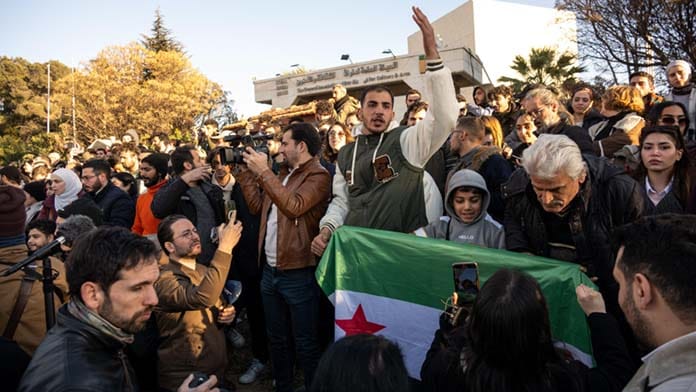After the toppling of the Assad regime in Syria, Maeve Larkins looks at key questions on the legacy of the 2011 revolution and what his fall means for Syria and the region
What was the al-Assad regime?
Dictator Bashar al-Assad ruled Syria from 2000, inheriting his position from his father, Hafez al-Assad. Together, the al-Assad family dominated Syria for more than 50 years.
Their regime was brutally anti-democratic and enriched a small, privileged elite at the expense of ordinary Syrians.
When Bashar al-Assad came to power, he implemented sweeping austerity, cutting welfare and subsidies for necessities like electricity and water and further privatised state assets.
On the eve of the 2011 revolution, a third of Syrians were living below the poverty line. In some cities in the south, poverty rates had doubled in five years.
What was the 2011 revolution?
In 2011, popular revolutions involving millions of people overthrew the dictatorships of Ben Ali in Tunisia and Hosni Mubarak in Egypt.
Demonstrations began to sprout across Syria. After the arrest and torture of young teenagers on 6 March for writing “the people want to overthrow the regime” on the wall of their school the movement exploded across the country.
Mass protests were met with live ammunition. By the end of March, hundreds of protesters had been killed.
Assad resorted to savage repression to save his regime. He began besieging entire cities, cutting off basic necessities and raining artillery and air strikes on them. But many Syrian soldiers refused to carry out their orders, defecting to join local protesters and forming armed militias loosely organised as the Free Syrian Army.
Assad drowned the revolution in blood. Millions were displaced and entire neighbourhoods reduced to rubble.
Increasingly, the Syrian revolution became dominated by armed groups fighting the regime. These forces largely relied on foreign funding and arms and, as a result, they became tied to the various imperialist interests backing them.
Russia, Hezbollah and Iran backed the regime while Turkey and the Gulf States back the armed opposition.
Syria is ethnically and religiously diverse, including Sunni Muslims, Alawite Muslims, Christians, Kurds and other groups. The regime worked to turn the struggle into a sectarian civil war, releasing jihadists they had imprisoned and using sectarian militias to carry out atrocities.
Islamic State and other foreign fighters also moved into Syria, so the armed rebellion took on an increasingly sectarian character.
Is Assad’s fall a continuation of the 2011 revolution?
The offensive in December 2023 that toppled Assad was not based in a mass movement like 2011. An essentially unimpeded march of rebels led by Islamist group Hayat Tahrir al-Sham showed that the regime had rotted from the inside.
One regime conscript stationed near Idlib described how there were meant to be three times as many Syrian army guards there but the officers had fabricated rosters to pocket extra wages.
When the conscript heard that HTS the tanks were rolling towards him he simply stripped off his uniform and went home. Across Syria, there were similar scenes, with abandoned regime uniforms littering the streets.
The horror of Assad’s counter-revolution had completely hollowed out any support for the regime. The regime ruled purely by fear; it was infamous for industrial-scale torture, indefinite incarceration and routine disappearances.
The regime was also weak and impoverished after more than a decade of sanctions and civil war. It relied on support from Russia, Iran and Hezbollah to keep control. But with Russia pre-occupied with Ukraine, and Iran and Hezbollah facing ruthless Israeli aggression, Assad’s allies were in no position to save him.
Assad’s fall brought Syrians into the streets in massive rallies. People began to tear down statues, Assad’s pictures and whatever remnants of the regime they could find.
The fall of the regime opens new possibilities for struggle for the democratic hopes that inspired the 2011 revolution.
But the situation is significantly different from 2011. Grassroots demonstrations have sprouted across Syria, including firefighters, Christians, women’s rights activists and others.
But the vast majority of the population are living in dire circumstances. When a local chef announced on social media that free food would be handed out in central Damascus, a crowd gathered, so large that some people were trampled to death.
The task of the left is to fans the flames of revolt; to mobilise the struggle for basic services, better wages and non-sectarian democracy against the transitional government as they try to consolidate their own power.
Who are HTS?
Hayat Tahrir al-Sham, or HTS, are an armed Islamist group which formed in the region of Idlib. Their leader Mohammed al-Jolani, who now goes by his real name, Ahmed al-Sharaa, was previously the leader of an al-Qaeda affiliate, the Al-Nusra Front.
When the Idlib region had been wrested from the regime in 2015, rival militias jostled for control until HTS, formed by the merger of several jihadist militias, militarily crushed its rivals to establish itself as the dominant force.
In practice, it was a one-party state with a form of crony capitalism, where monopolies over oil and other industries were granted to supporters of the party.
Yet, despite HTS’s efforts to suppress opposition movements, including with tactics like ramming protesters with armoured cars, popular demonstrations forced them to make concessions. Christians were allowed to hold church services, women were allowed to attend universities and drive cars. Protests won the release of political prisoners, the lifting of roadblocks and even succeeded in excluding HTS from some towns.
HTS are seeking to scale up their government from Idlib to the whole of Syria.
Pragmatically, they are assuring the stream of foreign diplomats who are visiting them that they will protect the rights of religious and ethnic minorities and will not seek to further “destabilise” the region by waging war on Israel or provoking another popular uprising.
There will be a huge gap between the promises of HTS for a secular and democratic state and the reality of the regime they want to consolidate. HTS have already back-tracked on their promise of elections within a year, saying now that it will have to wait four years.
They have courted supporters of Assad’s regime, such as the Damascus Chamber of Commerce, as well as former state functionaries.
The newly appointed HTS economic minister has promised “a free competitive economy” with huge cuts to the public sector. While they’ve announced a 400 per cent increase in public sector wages, it will apply only to those who remain after a review of 1.3 million employees. Only those with “sufficient expertise, academic qualifications, and the necessary skills for reconstruction” will be kept on
The promises of a non-sectarian state already seem hollow as government positions are being handed out almost exclusively to HTS leaders, many with track records of religious authoritarianism.
The new justice minister was recorded in 2015 proclaiming death sentences and overseeing the execution of two women in Idlib accused of sex work. Although HTS says that they have now moved beyond such behaviour, there are now calls for the justice minister to be removed.
Who are the Kurds?
The Kurds are an ethnic group that has suffered decades of oppression. More than 30 million Kurds are divided between Turkey, Syria, Iraq and Iran.
In Syria, Hafez Al-Assad stripped them of citizenship and sent Arab settlers to drive Kurdish farmers from their land.
But the Kurds failed to support the 2011 revolution. The Democratic Union Party (PYD) took the opportunity to seize control of Kurdish areas in Syria’s northeast, operating militarily as the People’s Protection Units (YPG). It is linked to Turkey’s Kurdish armed struggle movement, the PKK.
The PYD allied itself with the US, receiving funds and training to help fight Islamic State.
Turkey, a major backer of HTS, wants the complete destruction of Kurdish autonomy in Syria as a major priority, as it seeks to suppress its own Kurdish minority. During the December 2024 offensive, the Turkish-backed Syrian National Army began attacking Kurdish areas. Hundreds of thousands have been displaced.
The Kurds are now under serious threat and need the support of the kind of non-sectarian popular movement across Syria that was seen in 2011. Democracy fighters need to demand that all foreign troops, Russian, Turkish, US and Israeli, be withdrawn from Syria.
What does the fall of Assad mean for Palestine?
Israel responded to Assad’s overthrow with air strikes on military bases to destroy Syrian fighter jets, missiles and military capabilities. It has seized a “buffer zone” beyond its existing occupation of Syria’s Golan Heights, including the strategic Mount Hermon.
For some, this confirmed their view that Assad’s collapse is a blow to Palestinian liberation, since Syria was seen to be part of the “Axis of Resistance” between Hamas, Iran, Hezbollah and the Houthis.
But the Assads were no reliable supporters of Palestine. Syrian troops invaded Lebanon in 1976 to crush Palestinians forces and the left. In the 2011 revolution, Palestinian refugees in the Damascus neighbourhood of Yarmouk faced brutal repression for supporting protests.
The Axis of Resistance was never going to free Palestine. Their military capabilities are simply no match for the military power of Israel and the US. But crucially both Assad and Iran’s ruling class were far more concerned with maintaining their own power than consistently fighting Israel or Western imperialism.
The Arab rulers of Jordan, Egypt and the Gulf States have also betrayed the Palestinians. Palestinian liberation will only be achieved from below, by mass movements that topple these regimes and uproot the imperialist order in the region.
In the aftermath of Assad’s downfall, Egypt’s dictator al-Sisi has been petrified. He banned all Syrians from entering the country and released a doctored video where he pretended, “My hand has not been tainted with anyone’s blood.”
The overthrow of Assad has the potential to rekindle the spirit of the 2011 Arab Spring and inspire the kind of popular working class movements in the region that can break the stranglehold of imperialism and its brutal watchdog, Israel.
For this reason, supporters of Palestine should celebrate the downfall of the regime.






